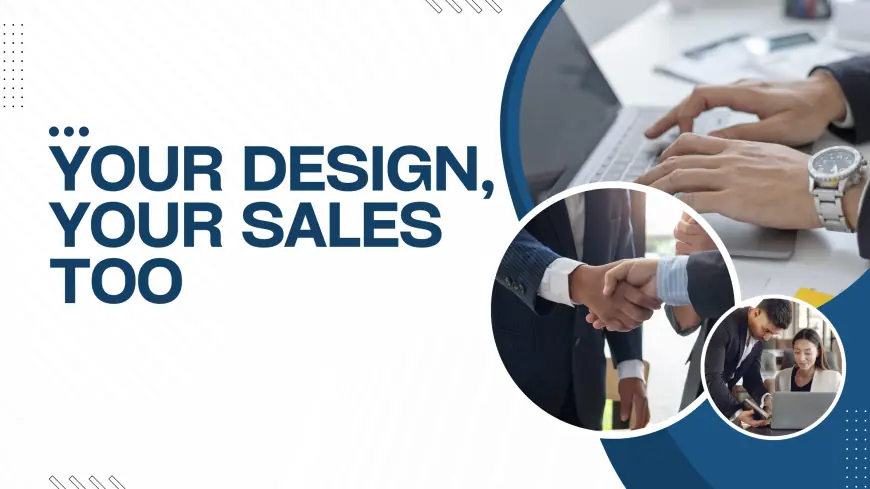First Impressions That Last: Why Design Is Your Silent Salesperson
Web Design Penarth creates modern, responsive websites that help businesses stand out online and connect with their audience

In the competitive digital world today, often the website forms the first point of contact between potential clients and your business. The first seconds are crucial as they decide whether a visitor will continue showing interest or drop off to a competitor's site. Every element that Web Design Penarth creates has an instant attention-grabbing quality to it, manifesting all under the personality and professionalism of your brand. From colour selection to typography, layout and imagery, design speaks your business values even before a single word has been read. An unpolished design with a deliberate purpose signals the visitors that you are trustworthy, credible, and worth spending time on against all odds, and that sets the foundation for stronger connections and conversions.
Yet, a genuine impression does not lie in the beauty of the face; it really emphasizes the clarity and easiness from the very first moment one sets foot in the door. Intelligent design immediately sets the visitor straight up on who the person is, what he offers, and why he should choose him. Strategic attention-grabbing calls-to-action, effortless but instinctive navigation, and quick download pages all alleviate friction. People find what they need within seconds, making it likely they stay a while, engage, and, eventually, turn into loyal customers. Hence, your site becomes a strong, silent salesperson, working tirelessly to represent your business in the best light possible.
Blending Beauty with Purpose: The Balance Between Looks and Function
It is worth noting that aesthetic appeal is not all that great web design is about. A website such as this gives an empty, beautiful appearance to its pages and acts all that while frustrating the user because it fails to help achieve some business goals . The best of designs have the form and function intertwined completely with each other so that every single visual choice has a reason for being. It involves picking pictures that are not only beautiful but work with your message and arranging them so that they guide visitors naturally in what you want them to do. In this sense, design artistry is wedded to user-friendly structure.
It is, thus, about looks and utility. Heavy, unoptimised images appear expressing beauty, but they're slow and stop your site before anyone sees the content. A really wise designer employs simple, small sized, optimised images, and logical layouts in order to fasten speed and functionality without losing beauty. So, a site can attract attention, and it will be more likely to hold it, leaving your viewer wanting to spend more time and do more things.
User Experience as a Business Strategy, Not Just a Design Choice
More than just a creative choice, user experience (UX) is critical for business strategy. The manner people interact with your site is likely how they view your brand and decide whether to take the next steps. A well-designed UX has taken care of all key stages in the customer journey-from the initial point of accessing the homepage up until completion of buying or enquiry forms. This will mean understanding audience needs, wants, and behaviours to create an experience that feels really natural and intuitive.
User experience for strategy means designing with understanding. Every button, every menu, every content section must have a clear purpose and must match business objectives. E.g., Key page clicks must be minimized. Forms must be easy to fill out, and all information must be easier to find. That's how to complete user journey satisfaction. When your website feels easy to navigate, visitors are likely to stay and come back to tell others about it.
Storytelling Through Design: Turning Your Brand into a Visual Narrative
Your site can conveniently allow the consumer to narrate their own story but does not guarantee the success with words. The picture speaks a thousand words—that would be the messaging of this proposition. External storytelling, one might say, involves colors, fonts, images, and layout to generate emotional connections with visitors. Your really well-done visual storytelling will portray your values, your mission, and many of the different peculiarities of your business that make you different. It is more about building the connectedness toward a brand identity than decoration.
It is possible to take a design story and put it to such an effect that the visitor has to feel something. A site that is emotional will probably be retained in memory and referred to more often than otherwise. In the end, you tie your brand's journey up with the specially designed experience to get people traveling in the direction you want them to move. When an emotional connection is created, whether it is through logic or not, it builds trust, loyalty, and advocacy; thus, casual browsers will turn out to be very strong supporters of your business.
Optimising for Conversions: Guiding Visitors to Take Action
The major purpose of an ordinary business website would be to convert immediately into action-an act of making purchases, booking a service, or even joining a mailing list. Intelligent web design includes strategies designed to make conversions a part of the layout. Such strategies make bland but persuasive calls to action without being pushy. This may mean putting the contact forms in touch with easy access or using a button text that sparks a bit of curiosity.
Besides, conversion optimisation is working with reduced drainages. A cluttered page full of too many conflicting elements tends to scare away box visitors into abandoning the whole exercise. By stripping down the design as simple and focusing in on the place that counts most, you will really make it simple for them to do the action you want them to take. Every single design decision would be intentional, capable of supporting your overall intention to translate interest into measurable results.
The Role of Mobile-First Design in Modern Business Growth
Anyone who isn't thinking 'mobile first' today is fast running out of options at best. The utmost consideration for these approaches is a smooth user experience on any device with good screen resolution. The text should be readable without any zoom, buttons should be easy to tap, and images must load fast in a proper way. A site that works beautifully on mobile phones not only manages to keep the visitor's attention but should also send positive signals to search engines and create an impact on ranking.
Mobile-first design also makes you put focus on important stuff. There's no option of prioritizing in smaller screens—one must keep away anything that makes the site cluttered. This helps push the design into cleaner layouts, no-frills-focusing layouts that automatically boost user experience across all devices. Companies that embrace mobile-first design will thereby reach customers wherever and whenever they are surfing, granting these companies a competitive edge in the online marketplace.
Future-Proofing Your Website: Designing for Tomorrow’s Needs
As technology changes so profoundly so quickly, what works now may actually be obsolete in just a couple of years. Future-proof web design should see a website that can be altered to any user behavior, change in devices, and industry standards. This includes flexible platforms, scalable design systems, and guarantees with aligning emerging technologies. Such forward thinking minimizes the need for expensive remodelings later on, keeping your business always relevant in this rapidly changing digital world.
Future-proofing, however, is designing for expansion. Your website should develop with your company, be it the addition of new services, e-commerce integration, or further sophisticated features. By anticipating these requirements well into the future, you keep your website operating effectively to become more of a long-term asset driving business success into the future.
What's Your Reaction?
 Like
0
Like
0
 Dislike
0
Dislike
0
 Love
0
Love
0
 Funny
0
Funny
0
 Angry
0
Angry
0
 Sad
0
Sad
0
 Wow
0
Wow
0


















































